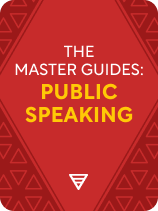

This article is an excerpt from the Shortform book guide to "The Master Guides: Public Speaking" by Shortform. Shortform has the world's best summaries and analyses of books you should be reading.
Like this article? Sign up for a free trial here.
How do you give a speech that will grab and keep the attention of the audience? What does it take to make a speech engaging?
To engage an audience, you should focus on creating a strong opening and then finding a way to connect with them emotionally. Learning strategies to do these two things will help you give a more effective speech.
To learn how to engage an audience, check out the following tips and strategies.
Engaging Your Audience
When considering how to engage an audience, you should prioritize an attention-grabbing opening, and then you can follow that with engaging content to keep that attention.
Write a Strong Opening
You only have about 60 seconds to keep your audience’s attention once you begin your speech. You may want to say something dramatic within the first minute, show a fascinating image (this can be beautiful, confusing, or funny), or pique their curiosity with a question or counterintuitive statement.
Likewise, you should keep your opening succinct by refining it to a sharp, powerful sentence or two. There are several weak ways of opening a speech that you should avoid:
- Don’t open with an apology. Often used to seem humble, this technique makes speakers look incompetent or unprepared and can annoy audiences.
- Don’t open with humor. Most speakers can’t pull off jokes, so you’ll most likely make the audience cringe and pull away emotionally.
- Don’t open too formally. Scripted, overly rehearsed, and/or dry openings easily lose the audience’s attention.
Connect With Your Audience
In The 16 Undeniable Laws of Communication, John C. Maxwell says that, to engage your audience during your presentation, you must focus on connecting with them. Connection breaks down barriers that prevent people from listening to you, which makes them more receptive to you and your ideas. Maxwell suggests a few ways to engage and connect with your audience:
- Put yourself in the audience’s shoes. Consider what they feel, think, and desire, and make them feel valued in ways that are important to them. You can do this by interacting with them, expressing your gratitude, or celebrating their accomplishments. In Public Speaking for Success, Dale Carnegie also suggests using familiar in-group words and ideas, like a Richard Feynman joke for a group of physicists.
- Remove mental and physical barriers. For instance, be friendly and create a comfortable atmosphere so that your audience feels at ease. Or, instead of standing behind a large podium, try sitting by the edge of the stage.
Carnegie provides some other ways to engage and connect with your audience when presenting:
- Speak from your heart: Facts don’t convince—emotion does. Deliver your speech with passion and enthusiasm. If you’re not emotional about your subject, your audience won’t be either.
- Act confident: Take the stage with poise and presence. Remind yourself that you’re well-prepared, invested in your ideas, and here to educate an audience that came to listen to you.
- Speak conversationally, as if you’re chatting with a close friend. This will bring out a natural, sincere quality in your voice and help the audience feel connected to you.
- Show your individuality. Real stage presence comes from an authentic individual owning their personality. Speak, move, and express yourself naturally. Carmine Gallo explains that allowing yourself to be emotionally vulnerable is important because it shows your audience that you’re a human being who has feelings, just like them.

———End of Preview———
Like what you just read? Read the rest of the world's best book summary and analysis of Shortform's "The Master Guides: Public Speaking" at Shortform.
Here's what you'll find in our full The Master Guides: Public Speaking summary:
- How you can master public speaking—even if you fear it more than death
- Insights from leading experts on how to prepare and deliver a speech
- How to keep your audience's attention and stop them from losing focus






